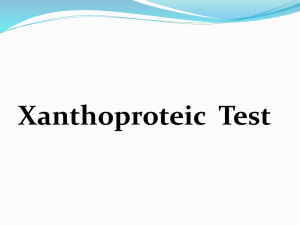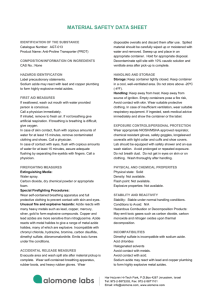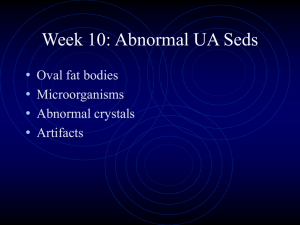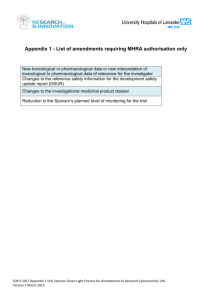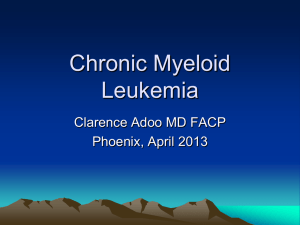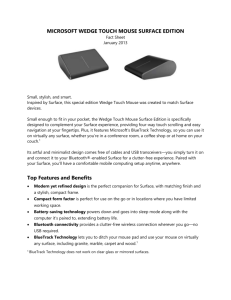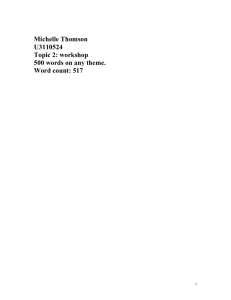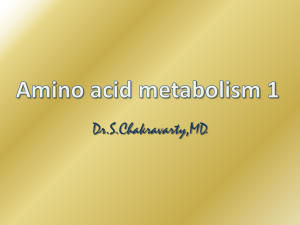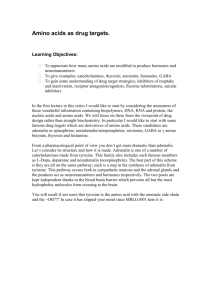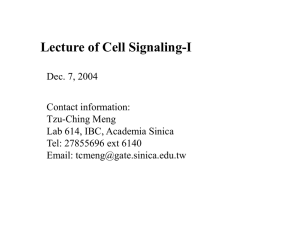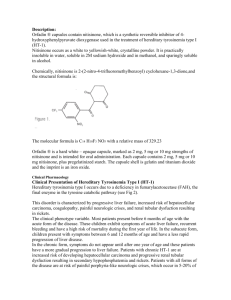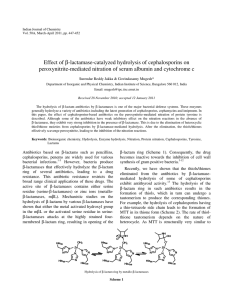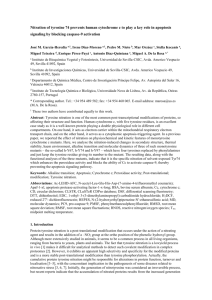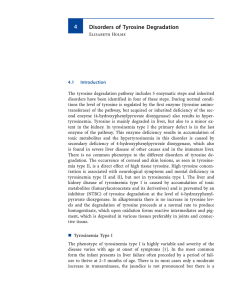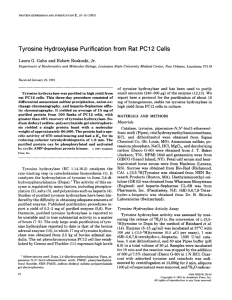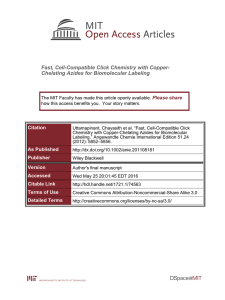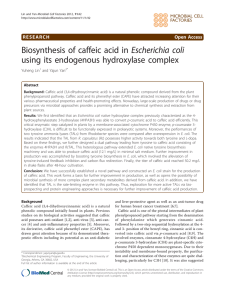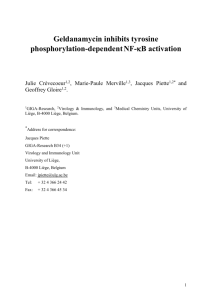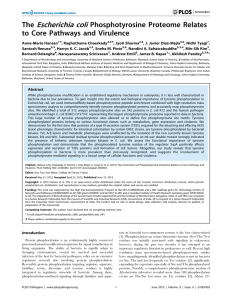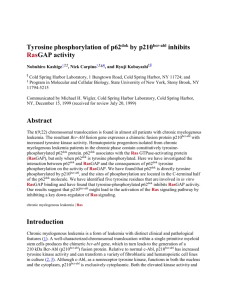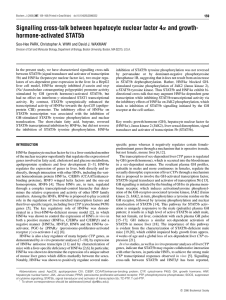click here
advertisement
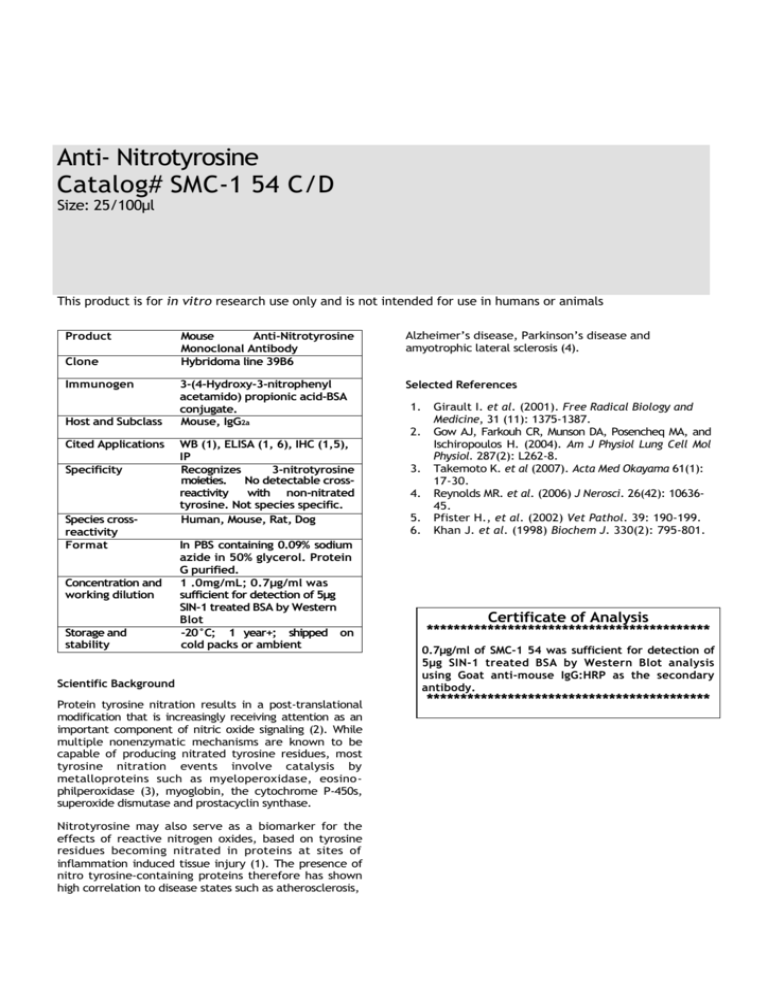
Anti- Nitrotyrosine Catalog# SMC-1 54 C/D Size: 25/100µl This product is for in vitro research use only and is not intended for use in humans or animals Product Clone Immunogen Host and Subclass Cited Applications Specificity Species crossreactivity Format Concentration and working dilution Storage and stability Mouse Anti-Nitrotyrosine Monoclonal Antibody Hybridoma line 39B6 Alzheimer’s disease, Parkinson’s disease and amyotrophic lateral sclerosis (4). 3-(4-Hydroxy-3-nitrophenyl acetamido) propionic acid-BSA conjugate. Mouse, IgG2a Selected References WB (1), ELISA (1, 6), IHC (1,5), IP Recognizes 3-nitrotyrosine moieties. No detectable crossreactivity with non-nitrated tyrosine. Not species specific. Human, Mouse, Rat, Dog In PBS containing 0.09% sodium azide in 50% glycerol. Protein G purified. 1 .0mg/mL; 0.7μg/ml was sufficient for detection of 5µg SIN-1 treated BSA by Western Blot -20°C; 1 year+; shipped on cold packs or ambient Scientific Background Protein tyrosine nitration results in a post-translational modification that is increasingly receiving attention as an important component of nitric oxide signaling (2). While multiple nonenzymatic mechanisms are known to be capable of producing nitrated tyrosine residues, most tyrosine nitration events involve catalysis by metalloproteins such as myeloperoxidase, eosinophilperoxidase (3), myoglobin, the cytochrome P-450s, superoxide dismutase and prostacyclin synthase. Nitrotyrosine may also serve as a biomarker for the effects of reactive nitrogen oxides, based on tyrosine residues becoming nitrated in proteins at sites of inflammation induced tissue injury (1). The presence of nitro tyrosine-containing proteins therefore has shown high correlation to disease states such as atherosclerosis, 1. 2. 3. 4. 5. 6. Girault I. et al. (2001). Free Radical Biology and Medicine, 31 (11): 1375-1387. Gow AJ, Farkouh CR, Munson DA, Posencheq MA, and Ischiropoulos H. (2004). Am J Physiol Lung Cell Mol Physiol. 287(2): L262-8. Takemoto K. et al (2007). Acta Med Okayama 61(1): 17-30. Reynolds MR. et al. (2006) J Nerosci. 26(42): 1063645. Pfister H., et al. (2002) Vet Pathol. 39: 190-199. Khan J. et al. (1998) Biochem J. 330(2): 795-801. Certificate of Analysis ****************************************** 0.7μg/ml of SMC-1 54 was sufficient for detection of 5µg SIN-1 treated BSA by Western Blot analysis using Goat anti-mouse IgG:HRP as the secondary antibody. ****************************************** Material Safety Data Sheet Anti-N itrotyrosine (Monoclonal Antibody) SMC-1 54 This product is for in vitro research use only and is not intended for use in humans or animals The below information is believed to be correct but does not purport to be all inclusive and shall be used only as a guide. StressMarq shall not be held liable for any damage resulting from handling or from contact with the above product. See the Technical Specification, Packing Slip, Invoice, and Product Catalogue for additional terms and conditions of sale. Hazardous Ingredients The physical, chemical and toxicological properties of these components have not been fully investigated. It is recommended that all laboratory personnel follow standard laboratory safety procedures when handling this product. Safety procedures should include wearing OSHA approved safety glasses, gloves and protective clothing. Direct physical contact with this product should be avoided. Known Hazardous Components Sodium Azide CAS Number 26628-22-8 Percent 0.09 Physical Data This product consists of mouse immunoglobulin in PBS containing 0.09% sodium azide in 50% glycerol shipped on gel packs. The physical properties of this product have not been investigated thoroughly. Fire and Explosion Hazard and Reactivity Data NOT APPLICABLE Toxicological Properties May be harmful by inhalation, ingestion, or skin absorption. The toxicological properties of this product have not been investigated thoroughly. Exercise due caution. Preventative Measures Wear chemical safety goggles and compatible chemical-resistant gloves. Avoid inhalation, contact with eyes, skin or clothing. Spill and Leak Procedures Observe all federal, state and local environmental regulations. Wear protective equipment. Absorb on sand or vermiculite and place in closed containers for disposal. Dispose or mix the material with a combustible solvent and burn in a chemical incinerator equipped with an afterburner and scrubber. First Aid Measures If swallowed, wash out mouth with water, provided person is conscious. Call a physician. In case of skin contact, flush with copious amounts of water for at least 15 minutes. Remove contaminated clothing and shoes. If a rash or other irritation develops, call a physician. If inhaled, remove to fresh air. If breathing becomes difficult, call a physician. In case of eye contact, flush with copious amounts of water for at least 15 minutes while separating the eyelids with fingers. Call a physician.
